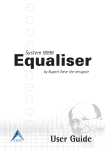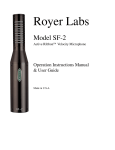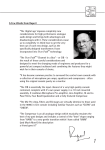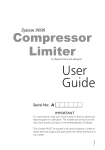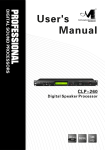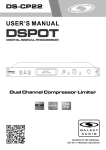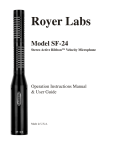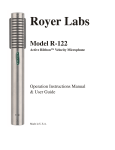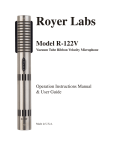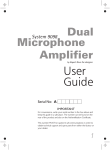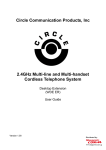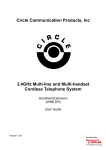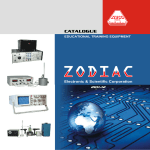Download DIB - PH Music
Transcript
Applications Notes: Driver in a Box A Harman International Company MIX AMP INPUT JUMPER OPTIONS LINE MIX AMP PHASE REV. PHASE REV. BLOCK DIAGRAM SHOWS FIRST TWO INPUTS AS EXAMPLE REMAINING INPUTS ARE SIMILARLY CONSTRUCTED INPUT 2 INPUT 1 INPUT JUMPER OPTIONS LINE Block Diagram GAIN TRIM -6dB to +14dB GAIN TRIM -6dB to +14dB DEFAULT=UNITY +10dB GAIN JUMPER OPTION RETURN SEND DEFAULT=UNITY +10dB GAIN JUMPER OPTION RETURN FADER/INSERT SEND FADER/INSERT LINK TO 3 INSERT OUT INSERT IN LINK 1-2 SILK SILK OUTPUT LEVEL TRIM PRESET SILK OUT SILK IN METER 2 OUTPUT LEVEL TRIM PRESET SILK OUT SILK IN METER 1 MUTE MUTE POWER UP MUTE CONTROL OUTPUT 2 OUTPUT 1 Applications Notes: Driver in a Box Contents Part 1: Traditional Audio Engineering ! Line sending in concert systems ! Linking distant parts of a broadcast complex ! Avoiding ground noise from digital, video and power circuits ! Optimising common mode rejection ! Multi-way distribution amplifiers ! Matching levels from DVD & other systems Part 2: Audio Enhancement ! Unbalanced inserts on mixers ! Input modes and level boosting from -10dBV sources ! Achieving high (+26dBu) drive levels ! Digital audio workstations ! PC sound cards ! Digital audio mixers ! Sonic enhancement and the "Mr. Rupert Neve sound” Part 3: Advanced applications ! Gain structure of the DIB. ! Additive and subtractive broadcast clean feeds ! DIB as an extended virtual earth mixer for foldback/matrix sends ! DIB insert points ! Wiring external linear and/or rotary faders to the DIB. ! The "Pure Path" mixing console Part 4: Technical Background You will find references to [Notes:] in this section. ! The behaviour of balanced lines ! Cable losses ! Output impedance ! Typical response curves ! Cable/interface resonance ! 600 Ohm loading ! Differential inputs and common mode rejection ! Ground potentials ! Circulating noise currents Part 5: Architects' specification Cross References [Note:] Many of the benefits obtained from the Driver in a Box (DIB) stem from a very high level of audio performance and it follows from this, that some of the issues involved are of a technical nature. To make for easy reading, the more technical issues have been placed in a separate section towards the end of these notes. The earlier text explains the practical benefits and the technical explanations are easily found by following the cross-reference system. Traditional Audio Engineering Audio engineering is about using electronics to get sound from one place to another, generally along copper cables, with the only changes to the sound being those you choose to make. Many things can happen to sound after it leaves the audio mixer where it is usually controlled. Line Sending Consider a typical concert situation(see Fig. 1) microphones on stage, perhaps a mic. splitter at the side of the stage driving cables to the front of house mixer. More long cables, probably multicore, sending controlled signals from the front of house mixer to amplifier racks, often also near the stage and separate feeds also to a foldback mixer. The first cause for concern is the ability of the front of house mixer, or very often the graphic equalisers, to drive the long cables. In some cases outputs may not even be balanced, but even if they are, questions of the cable behaviour [Note:1] and the graphic equaliser's output impedance [Note:2] become important factors. Sometimes losses on the return feeds to the foldback mixer and to the amplifier racks can be large, perhaps 5dB or more at 20kHz which makes a nonsense of any carefully designed frequency response! Because the AMEK DIB is an eight channel device with total isolation of the signals, choosing only the most critical signals can allow one or two DIBs to cover foldback and amp. rack feeds. Using a DIB as a sending amplifier can minimise these losses and also reduce the risk of noise being injected onto the line but problems are not always limited to losses and interference. The output circuit can interact with cable reactance to produce a resonant circuit - the type of network used in some equalisers - and this can cause peaks, often just above the audio band! Whilst this can sometimes give rise to audible effects, it can also cause instability (oscillations) in the system [Note:3]. Unlike much equipment, DIB is well able to drive low impedances so a 600 ohm load can be placed at the remote end of the cable, giving useful damping of any resonance and further improving the supersonic smoothness as shown in the curve overleaf. It may be necessary to adjust the internal output trim control to make up the level loss of around 1 dB that will be caused by the 600 ohm load but these trimmers have a range in excess of +3/-3dB and can also be used to make up other system losses. These can occur in installations with extra long cable runs such as stadiums. Mic. splitter FOH Mixer Foldback mixer Graphic equaliser Amplifier Racks Mic. splitter DIB FOH Mixer Foldback mixer Graphic equaliser DIB Amplifier Racks Figure 1: Typical connections in a concert situation. When shipped, the DIB is accurately calibrated to unity gain for high impedance loads so do not make adjustments unless you have good reason and any necessary calibration equipment! AMPL(dBu) vs FREQ(Hz) 5.0000 4.0000 3.0000 100k Ohm 2.0000 The issues illustrated by the concert example can be found in other situations, for example sending signals from a broadcast studio to a master control room in a distant part of the building. 1.0000 0.0 600 Ohm -1.000 Line Receiving -2.000 This time we'll use the studio / master control room example (see Fig. 3, over) to consider the benefits of DIB as a receiver of signals though the same principles can be applied in concert systems. -3.000 -4.000 -5.000 10 100 1k 10k 100k 200k One of the major issues that arises with input stages is mismatching caused by differences in ground potential. In an ideal environment, the technical and safety earths distributed to all parts of the system, maybe even in different buildings, would all be at exactly the same perfect earth potential. In the real world this doesn't happen because all manner of equipment is creating earth currents The trimmers are adjusted by removing the top cover as described in the User Guide, taking careful note of safety procedures! When adjusting the controls, take care not to come into contact with any part of the mains power supply which contains lethal voltages. Figure 2: Internal Layout of DIB Output link jumpers (replaced by rear panel switches on later models) Insert gain jumpers Output transformers DANGER HIGH VOLTAGES 1 2 3 4 5 6 7 8 Output level trims Input transformers 1 2 3 4 5 Input sensitivity jumpers 6 7 8 Studio sound desk Master control matrix DIB Local earth Potential difference! Local earth Figure 3: Studio/Master control room at mains frequencies, video frequencies and an entire spectrum of data clock frequencies! No matter how careful the earthing scheme and how thick the earth cables, earth at one location will never be the same as at another and all this can mean noise problems [Note:5]. Inserting the DIB gives an extremely high level of isolation to the audio signal so potential differences between two earths cease to cause problems. [Note:4] A further enhancement provided by the DIB is a high common mode rejection ratio. We hope that all master control matrices have inputs with a good CMRR. However, it can be useful to crosspatch signals from a control room in a distant part of the broadcast complex to other circuits with less good input characteristics. Time delays may need to be patched in to maintain lip-sync and the inputs of many delays are optimised for cost effectiveness when used in audio control rooms, not to be high grade line receivers. Once again, this may require only two or four channels of the eight channel DIB, leaving scope for one DIB to address a number of master control needs simultaneously! Distribution Amplifier The DIB can function to feed one or more signals to a variety of destinations with complete isolation between the various destinations. It is much more powerful than a conventional distribution amplifier because as well as its special input and output characteristics, it can be configured in a variety of ways. Pressing the "LINK 1-2" switch on the rear panel (or adjusting an internal jumper on early DIBs) causes output 2 as well as output 1 to be fed with the signal applied to input 1 and controlled by the front panel gain knob of channel 1. The internal trimmers remain available to allow separate adjustment of output levels when required (See Fig. 4). Also operating the "LINK 2-3" switch routes the same channel 1 input signal to output 3 and by pressing more buttons, more totally isolated feeds of the channel 1 input can be obtained. Not only can DIB become a distribution amplifier with up to eight outputs, but it can be configured to give fewer outputs from the first input, with the remained functioning either as single channel drivers or in other groupings. For example channels 1 and 4 could both have three outputs with channel 7 having two outputs. It is important to remember that when a channel has its link switch pressed, that input no longer drives that output, but the transformer balanced input is still available feeding the insert send. The extremely high isolation between signal paths in the DIB means that the input and output sections can be used separately, output sections giving a high performance distribution amplifier, whilst some of the otherwise unused input sections can be providing high quality line receiving circuits. Proper buffering is important when multi-channel signals, such as those from DVD players, are to be distributed to a variety of destinations. Most readily available DVD players provide audio on unbalanced "phono" type outputs and the DIB's eight channels can provide a convenient way to convert these to a robust "professional" format audio signal, for distribution around entertainment venues as well as production areas. Audio Enhancement Apart from the using the DIB to interface to long cables, there are also applications within localised areas. Insert points All serious audio mixing consoles have insert points in their channels, groups and outputs for patching effects devices. The majority in use today have insert sends and a large proportion have insert returns which are unbalanced. In many instances this works adequately, particularly if all effects equipment has been carefully installed. However, a pressured recording session is just the time when a newly 1 Input 1 2 Input 2 3 Input 3 Output 1 1 Output 2 2 Output 3 3 Output 4 4 Link 1-2 Link 2-3 Link 3-4 4 Input 4 to 5 etc. Figure 4: Link switches Sound desk channel Effects device DIB Local earth Potential difference! Local earth Figure 5: Connection to mixing console inserts added unbalanced item can give problems and the worst time for technical investigations! This is when DIB comes to the rescue by providing even a modest console with some fully balanced and totally isolated insert sends and returns (See Fig. 5). [Note:6] Using the DIB only on the send or return circuit can be sufficient to solve some problems, but if you have enough DIB channels to spare, isolating both send and return is always wise! lower than the signals nominally at +4dBu (i.e. wrt to 0.775 volts). Whilst DAT and other long established formats are available with professional balanced outputs, it can be expedient to buffer semi-professional equipment. However, with newer formats such as DVD a choice is not always available. Buffering with a DIB can prove a cost effective way to achieve balanced outputs and avoid extensive interfacing through domestic phono sockets! Console insert sends are sometimes not at the "+4" level used in other parts of the studio and the DIB gain control can be used to give full drive when needed. The "mixing" setting is described later. Level Boosting Serious audio editing is now possible on workstations using quite modest analogue audio facilities and such digital audio workstations (DAWs) have a number of points in common with console inserts! The inputs and outputs are often not balanced so all the issues discussed in [Note:4] and [Note:6] come into play. In addition PC systems using sound cards powered from a computer do not have high enough supply voltages to produce professional levels of over +20dBu. Good sound cards can have excellent analogue audio inputs and outputs when connected to single devices. Unfortunately the design of many PC power supplies means that although the dynamic range at the sound card connector can be very wide, it is impossible to achieve the lowest noise performance in a real installation because of power supply noise on the ground. The DIB comes into play providing total isolation between the noisy ground of the computer(s) and the clean ground of the rest of the audio installation. Levels through the DIB input and insert stages are restricted to +22dBu to match the capabilities of most studio equipment. However, when the highest signal levels are required, the full +26dBu capability of DIB can be exploited using the internal output trim controls. The DIB can then be set to provide +26dBu levels, even from sources only capable of more modest output levels.] Additional gain is provided by the "Input Sensitivity" jumpers (See Fig. 6). They are located near the input transformers. The default setting is unity gain which means with all controls at "0", +4dBu input gives +4dBu output. Moving them to +12dB increases the sensitivity to suit semi-professional equipment where the level on "phono" sockets is often -10dBV (i.e. wrt one volt) so about 12dB I/P txfr Unity +12dB Mixing Figure 6: Input sensitivity jumpers Digital Audio Workstations The eight channels of the DIB conveniently complement many workstations and also low cost digital audio mixers, many of which provide analogue I/O in blocks of eight channels. Low cost digital audio mixers should not have the same risk of power supply noise as PC systems as they are specifically designed for audio purposes. However, the inputs and outputs, sometimes unbalanced, are often not robust for sending and receiving from long cables [Note:5] [Note:6]. Here the DIB can be used with the input and output sections split by pressing the four "insert" buttons on the rear panel (See Fig. 7, over). The input sections are then used to give a high grade balanced input. Each unbalanced insert send is connected via a short cable to a mixer (or DAW) analogue input. Digital mixer Mixer I/P Mixer O/P Insert send Insert return High grade input Robust output Chassis Figure 7: Connection to a digital mixer Eight mixer/DAW outputs are connected with short cables to the insert return points and the DIB outputs become robust balanced outputs of the mixer or DAW. Sonic Subtleties All the preceding applications help to maintain the audio signal as unchanged as possible but of course sound engineering is also about creativity! Rupert Neve has been a leader in the field of subtle sound control for many years and it is no surprise that the DIB is designed in the engineering style for which he is famous. One aspect of this is a "silky" quality heard since his earliest transistor based designs. A special stage called "SILK" has been included in each output of the DIB and can be switched in individually to enhance that special sound on those outputs where it is required. Others can be left unprocessed with distortion and noise so low, they approach the measurement limits of test equipment! Advanced Applications The DIB can be used as an adjunct to other control systems but it can also be used as the core of an audio system. Input Front panel 0dB/+12dB/MIX (virtual earth) -6/+14dB Figure 8: Levels jumpers Insert point Mix Amplifiers The eight channels have internal jumpers that are normally set to provide balanced input amplifiers with unity gain, though of course the front panel input level controls and the internal output level trimmers allow other gain structures to be devised (See Fig. 8). An unusual feature is the internal jumper option to configure all (or as many of the input sections as required) as fully balanced virtual earth mix amplifiers. This opens up a wide range of applications including: * deriving clean feeds for broadcast (additive and subtractive) * summing line level feeds from other equipment * using the DIB as the core of an extremely high grade audio mixer. A broadcast clean feed is used to allow a remote contributor to be sent a mix of everything in the broadcast, except his own contribution. If he listens to the complete mix (See Fig. 9, over), his own contribution is likely to come back to him with a time delay and this makes conversation awkward and sometimes impossible as well as raising the risk of feedback problems. Insert gain 0/+10dB Insert in Output trim ±3dB REMOTE CONTRIBUTOR DIB MIX CHANNEL Contributor (post fade) Studio mics "Lo" Studio CDs etc. STUDIO SOUND DESK 5K1 "Hi" Transmission + 5K1 Clean feed - "Lo" "Hi" Transmission DIB Clean feed Figure 9: Cleanfeed There are two ways to derive a clean feed. On large mixers, a spare auxiliary send can be used to create an "additive" clean feed which sums together all sources, except the remote contributor. When there is no spare aux send, the DIB can make such a mix externally, adding together post fade signals from the required channels. This can result in a lot of signals to be summed, though summing selected sub-groups can minimise this. resistors. Even a modest 24 input, 8 output foldback matrix requires 24 x 8 x 2 = 384 resistors (See Fig. 10)! Whilst the circuit is extremely simple, care is needed to achieve a tidy layout which allows every incoming cable screen to be linked to a good ground point. This ground must be the same as that going into the DIB so any cable between the mixing resistors and the DIB input connector should be kept as short as possible to prevent noise. The alternative "subtractive" system is one which takes the complete studio output and removes the unwanted part of the mix. This is done by inverting the polarity (phase) of the signal to be subtracted then summing it with the total mix, thereby producing a cancellation. For this to work well, it is necessary that signal levels are correctly adjusted and there are no serious phase shifts or time delays within the control room, however the mixing scheme is greatly simplified. Careful engineering is needed if the DIB is to give its optimum performance when configured as a mixing system. AMEK's UK headquarters will be pleased to advise in any cases of difficulty. Because DIB mixing is done with fully balanced mix busses, the noise and crosstalk performance can meet and in some cases better the performance of the finest audio mixers on the market giving results well beyond what can be captured with most digital recorders. However, this level of performance requires care with the installation. Balanced mixing means every input requires two 5K1 Input 1 (balanced) Input 1 "Hi" Input 2 "Hi" Input 3 "Hi" Input 4 "Hi" Input 1 "Lo" Input 2 "Lo" Input 3 "Lo" Input 4 "Lo" 5K1 VE channel + 5K1 - Inputs 2-4 (similar) Figure 10: Virtual earth mixing Insert and Faders When the DIB is used as the core of a system, level control becomes important. Front panel level controls provide a "trim" function but full fader control is desirable. The insert point on each channel of the DIB can be used to insert other pieces of equipment, though its unbalanced sends and returns are designed to simplify connection of faders. Insert points are enabled in pairs by four push button switches on the rear panel. Do not switch them in, unless there is wiring to the insert connector or no signal will pass! Any good quality linear fader, or rotary potentiometer, with a track resistance of between 1K and 10K Ohms can be used (See Fig. 11, over). Separately screened cables must be used for the send and return wiring. This means two screen connections to the fader and two to the chassis ground pin in the DIB connector. Whilst using twin and screen cable may look simpler, it will give frequency response errors when the fader is anywhere except fully open. If rotary potentiometers are used, choose quality types with a logarithmic law. Low cost log. law devices can give poor matching so controls set to the same angle may give different amounts of attenuation. matrix between the CIB and the DIB. If any kind of switching system is being used, remember to keep the 5K1 resistors close to the DIB, not to a distant switch panel. Fader Cable 1 Cable 2 Many other combinations can be devised and your imagination can be allowed to fully explore the DIB's versatility! Technical Background Send 1 Return 1 24 25 12 Chassis ground Figure 11: Inserting a fader Having extra gain "in hand" when the fader or rotary potentiometer is at maximum is often useful. The DIB can be configured to have 10dB of gain in the insert return circuit so it gives unity gain with the faders 10dB below maximum. This is done by isolating the mains supply, opening the unit and following the procedure described in the User Manual. Then fit a jumper across each of the pair of "Insert Gain" pins before replacing the cover and reconnecting the mains input. "CIB" and DIB The AMEK DIB has two "Pure Path" sister products - the "Stem Compressor" and the "Channel in a Box". Complete systems can be configured by using various combinations of these (See Fig. 12). This example has the DIB inputs all set to be virtual earth mix points, faders connected at the insert points and outputs feeding into a Stem Compressor. The system can be simplified, with some inputs being simple level devices without equalisation, by making a direction balanced connection and not using a CIB. An enhancement can be the addition of a switch or electronic General For years, audio wisdom has correctly been that if equipment has unbalanced inputs and outputs, it is not a good idea to use long cables. It is often believed that if connections are balanced, line length ceases to be an issue and cables can be as long as needed. Sadly, things are never quite so simple! It is useful to look at how inputs, outputs and the cables that connect them really behave when in use and from this, it begins to be apparent that not all balanced inputs and outputs are created equal. Significant benefits are obtained by sending and receiving signals with a device made for that purpose. By understanding what happens to signals, we see why this is true. Cable Behaviour [Note:1] Of course, balanced signals are more robust than unbalanced ones, but they are still subject to the laws of physics! Whatever cable is used it has three important electrical characteristics - resistance (R), capacitance (C) and inductance (L). These characteristics combine to produce a network which is approximately like Fig. 13, over. It isn't necessary to understand the details, but it is easy to see that the circuit has a number of components in common with equalisers i.e. things which change the frequency response! Of course different types of cable have different values for Channel in a Box Faders DIB Stem Compressor Figure 12: Example of a Pure Path® mixing system circuit element R L R C R L L R L C element is repeated many times L R R L Figure 13: Electrical characteristics of cable the resistance, capacitance and inductance and short cables have lower values than long ones. A rule of thumb is that thick cables with more copper in them have lower resistance, but even the thickest and lowest resistance types still have some resistance and the inductance and capacitance mean frequency response errors can be very significant. could have a loss of 5dB at 21kHz using the simple analysis above. In reality other effects relating to the cable and the input and output circuits come into play and the behaviour in all cases is not simple to predict but a low output impedance certainly helps avoid such roll offs. For example the same cable driven by an output impedance of 100 Ohms has a loss of only 1dB at 21kHz instead of 5dB. Output Impedance [Note:3] Consider the cable equivalent circuit, further simplified and re-arranged. Things are not too bad with quality cables up to a few tens of metres long but the cable is only part of the story. The device driving the cable has a big effect on what signal finally comes out at the far end. Let's consider the sort of arrangement often found in a live concert situation with a mixer driving a graphic equaliser and the equaliser driving a long cable to the amplifier racks. To simplify matters, we will ignore the inductance of our cable and any inductance in the output of the graphic equaliser driving the cable. [Note:2] If the output impedance is more than just a few ohms, even as low as 600 Ohms, cable capacitance will cause the frequency response to fall above some frequency (See Fig. 14). As an example, 100m of a typical installation cable (100pF/m) driven from a 600 Ohm output The inductance and capacitance form a resonant circuit which causes peaks. These peaks are typically in the supersonic region somewhere between 30kHz and 200kHz and the overall performance becomes complex to calculate with HF peaks combining with rolls offs from various causes to give a highly irregular frequency response (See Fig. 15). Video and RF engineers are familiar with the need to terminate lines. This means placing a load at the end of the line with a resistance equal to the characteristic impedance of the line. This is not usually important in analogue audio systems, but with very long cables, a terminating resistor can improve the frequency response. In particular, it can cable equaliser output amplifier input Ro C Ri level Ro frequency Figure 14: Output Impedance cable output R Ro Ro input L level C R Ri level L frequency Figure 15: Resonance reduce the size of any resonant peaks which occur in the supersonic region. With the DIB, a 600 ohm load is a suitable value to add to the end of long cables and will give much smoother supersonic performance. It will also reduce the overall signal level by around 1dB but this can be compensated with the internal output level trim control. Input Stages Now let's think about the effect input stages can have on the behaviour of interconnected equipment. Electronically balanced inputs provide good performance in many applications but have some limitations as receivers from long lines. There are three main risks. Two relate to the lack of ground isolation and the third concerns the input's ability to reject signals that are not properly balanced. The assumption that makes balanced lines desirable is that the signal is a "differential" one. This means that it has a "hi" side and a "lo" side with the signal on one side being Voltage on the "hi" wire Voltage on the "lo" wire Figure 16: Balanced waveform exactly the opposite as that on the other, shown by the waveforms below (See Fig. 16, solid lines). At a balanced input, the circuit subtracts the voltage on the "lo" wire from that on the "hi" to derive the desired input signal. In other words, its has derived the difference between the two wires which is why it is called a "differential input". Balanced circuits are good at rejecting noise that may be picked up in the interconnecting cable because most noise signals affect both the "hi" and "lo" wires almost identically as shown by the dotted lines. When the input circuit does its subtraction, the noise on both the "hi" and "lo" wires is the same so is cancelled. For this process to work perfectly the noise on the two wires must be identical but the input amplifier must also be capable of doing a perfect subtraction with no errors. Real input amplifiers are never this perfect and a small amount of the noise signal that was common to the "hi" and "lo" wires (the "common mode signal") gets through the input and is mixed with the audio. The ability of input amplifiers to avoid this noise is called break output cable input output cable input X current Ri no current? Ri Figure 17: Balanced input driven from a balanced output the "common mode rejection ratio". [Note:4] For a whole range of reasons, electronically balanced amplifiers are difficult to design with good common mode rejection ratios at all frequencies. A circuit good at rejecting mains hum and other low frequency noises, may not work as well at the high frequencies which cause radio breakthrough. Quality transformers are a proven solution that can give good common mode rejection (CMMR) figures across a wide range of frequencies. The larger the negative number for CMMR, the better the rejection of noise. Output circuits also have a complementary performance aspect called "output balance". For perfect operation, the audio signal on the "hi" and "lo" sides must be identical but inverted to each other. Electronically balanced outputs can provide slightly different drive to the "hi" and "lo" sides, so impairing the noise rejection. Using a transformer output is an effective way to ensure a good output balance figure. A balanced input driven from a balanced output can be thought of as a simple circuit with current flowing along one leg, through the input and back up the other leg (See Fig. 17). Of course the signal is an AC one so the current keeps reversing direction but this doesn't affect our analysis. If the circuit is broken, a simple view might be that all signal should disappear as current can no longer flow around the circuit but sadly this rarely happens! In most cases the signal drops slightly but does not disappear. Whilst this might be useful if our cables are faulty, it does not help good noise performance which is after all why balanced circuits were adopted in the first place! The reason the signal does not disappear starts to be apparent when we see a more accurate approximation of the electronically balanced input circuit (See Fig. 18). The electronically balanced input stage has an input impedance between the "Hi" and "Lo" terminals (Zi), but there are also impedances, which for the sake of simplicity we can think of for now as resistances, between each of these "legs" and ground (Zh and Zl). These are unavoidable with electronic balanced inputs because of the need for all the electronics to be referenced to it's power supplies. The drawing to the right of Fig. 18 shows the same circuit but is rearranged for clarity! Although the "Hi" terminal is open circuit current still flows through the input impedance Zi and is amplified as any other received signal! In reality, these impedances are not simple resistances but a complex mixture, mainly of resistance and capacitance so the signal that gets through often has a modified frequency response. Of course we hope our cables don't cause one leg to become open circuit but what we are really looking at is any situation where the signal on the "Hi" side is not a perfect mirror of that on the "Lo" side. This is something which does happen very commonly when noise is injected onto a cable. If we are very lucky exactly equal amounts of noise might be injected onto both the high side and low sides of the cable and our balanced input can then cancel this "common mode" signal. Sadly, in the real world it is usual for the noise injected onto the two legs of the cable to be slightly different. Fortunately this difference is attenuated by the three impedances Zh, Zl and Zi. If Zh and Zl could be made infinitely high, this attenuation can become perfect and we can get something close to complete rejection of line noise. Although Rupert Neve and AMEK produced a very close approximation to this with their "Transformer Like Amplifier" stage, a real transformer is a secure way to ensure noise immunity. This points us towards an important requirement for our ideal receiving amplifier - transformer coupling - but this also gives another important benefit. An input that has no reference to earth avoids problems when connecting equipment that is operating with differences in ground potential. This can happen when the pieces of equipment are physically distant and connected via long cables. Ground Potentials [Note:5] The difference in grounds often shows as a voltage at mains power frequency and can be several volts or tens of volts - often larger than the audio signal! input Hi X Hi Zi = Lo Zh X Zi Lo Zl Zl Zh Scn Scn Figure 18: Ground potential Hum can sometimes be avoided by breaking a screen connection but with electronically balanced inputs and outputs the noise will only be cancelled if it is within the range of levels that can be handled by the input stage. If ground differences are several tens of volts, the input amplifier can be overloaded even before any audio signal is applied and mixtures of hum and audio are hardly desirable! [Note:6] Matters get even worse when inputs and output are unbalanced as it is often impossible to break the screen connection, being an essential part of the circuit. Fig. 19 shows the "send" part of the connection, but identical problems can occur with the return. Adding a DIB can provide fully balanced insert connections so avoiding the ground loop and the circulating noise signal, often hum. Conclusions The only safe way to make connections using anything other than the shortest, carefully made and laid studio cables is with transformer coupling both at outputs and at inputs. Many modern mixers and other devices provide only electronic balancing, and some are not even balanced and can cause catastrophic problems. Several of the effects described occur in the supersonic region above 20kHz but AMEK and Rupert Neve have long stressed that the behaviour of audio systems in these regions contributes greatly to the "sound" of audio systems. The AMEK Driver In A Box avoids all of these problems. Architects' Specification The driver/mixer unit shall be housed in a steel enclosure with dimensions of 445mm (17.52") wide (excluding the front panel projections for rack fixing), by 44.5mm (1.75") high by 308mm (12.13”) deep. The enclosure shall be of a style and have fixing holes to suit standard 19" rack enclosures with an overall front panel width of 482mm (18.98"). All surfaces shall be durable against the normal wear and tear experienced in professional studio and related environments. The unit shall be mains powered from AC supplies of either 50Hz or 60Hz and amplitudes between 100 volts and 240 volts without requiring any switch or other adjustments. All audio inputs and outputs should be on 25 pin Sub-D type connectors with provision for them to be securely locked in place. The mains input should employ a detachable lead with a rear panel IEC (CEE22) connector. There shall be eight separate audio channels having a high degree of isolation between them to facilitate their independent use. Facilities shall be provided to allow the linking of adjacent channels into groups of two or more channels. Each of the eight inputs and outputs should have transformer coupling to provide a high degree of ground isolation. The overall design should minimise susceptibility to radiated electromagnetic fields and the unit must not be a source of significant levels of radiation. Each of the eight input channels shall have a front panel illuminated push button switch providing a phase reverse (polarity invert) function and a front panel level adjustment having a range of -6dB to +14dB. Channels shall also have insert points on the rear panel with switching provided to place the insert points of adjacent channels in or out of circuit. This insert point is to be unbalanced to facilitate the connection of external faders and provision must be made for these to operate with a path gain of either 0dB or +10dB when the fader is in the fully open position. An additional 12dB gain shall be selectable to individual inputs by the use of internal jumpers. Each input shall be able to function as a fully balanced virtual earth mix buss by the addition of external summing resistors. All eight output stages shall be equipped with separate level meters calibrated from -30dB to +10dB and illuminated push button mute switches. Level adjustment shall be provided with internal controls. The frequency response shall extend several octaves beyond the traditional audio bandwidth with harmonic distortion at 1kHz less than 0.001%. Special audio processing shall be separately switchable into each of the outputs to give a sonic effect similar to that provided by "Class A" audio mixing consoles designed in the 1970s and 1980s. All controls and indicators shall be clearly labelled with their functions and comprehensive supporting literature shall be provided to describe their correct operation. Insert send Effects device input "Hi" Scn Circulating noise current Figure 19: Unbalanced Technical Specification Power Requirements Line Input AC ~ input 50-60Hz, 100V-240V Gain -6dB to +14dB Input Impedance Bridging Input Impedance >10kW Input Balance (CMRR) Unity gain @1kHz Better than -65dBu Max 30W Dimensions 19” 1U rack unit Depth including connectors 482mm x 44.5mm 382mm Weight 5.75 kg THD+Noise Unity gain setting, input/output level +10dBu, measured at output Frequency Response 5.0 4.0 (Bandwidth 22Hz-22kHz) THD measured @ 1kHz Better than -98dBu Better than 0.001% ...figures for distortion are identical for loads of 10kW 600W . 3.0 2.0 1.0 and 10KW 0.0 -2.0 -3.0 -4.0 -5.0 Outputs Maximum Output Level Balanced and floating transformer Measured at Main output with 10kW Measured at Main output with 600W ...with output gain at nominal. load load +23dBu +22dBu The internal output trim control can give an additional 4dB of gain. The maximum output drive capability is +26dBu Insert Points Send output impedance, unbalanced @1kHz Return input impedance, unbalanced @1kHz 600W 10 0.5 1K 10K Load 100K 200K Distortion 0.01 50W 100kW 0.001 0.0005 -50.0 Frequency Response load impedance load impedance 100 0.1 Crosstalk Unity gain setting, Insert IN, output level +10dBu Measured @ 1kHz Better than -100dBu 10kW 600W Load -1.0 20 100 1K 10K 1K 10K 20K Bandpass Noise -60.0 10Hz - 200kHz (-2dB) 10Hz - 120kHz (-3dB -70.0 -80.0 -90.0 -100.0 -110.0 -120.0 -130.0 20 100 20K A Harman International Company International Headquarters Langley House Third Avenue Trafford Park Manchester M17 1FG Tel: +44 (0) 161 868 2400 Fax: +44 (0) 161 873 8010 Web: www.amek.com Email: [email protected] US Headquarters 1449, Donelson Pike Airpark Business Centre 12 Nashville TN37217 Tel: +1 888 286 9358 Fax: +1 615 360 0273 Los Angeles 2740, W Magnolia Blvd #102 Burbank CA91505 Tel: +1 800 585 6875 Fax: +1 818 973 1622 Tokyo 3-5-14, Konan Minato-ku Tokyo 108-0075 Tel: +81 (0) 3 5707 0575 Fax: +81 (0) 3 5707 0599 The company has an established policy of seeking improvements to the design, specifications and manufacture of its products. Alterations take place continually, often without prior notification outside the company. The contents of the company's literature must not be regarded as an infallible guide to the specifications available despite considerable effort to produce up-to-date information. No literature constitutes an offer for sale of any particular console or product. The company's officially appointed distributors and representatives will advise on any changes when the circumstances of the enquiry permit. © 2000 Harman International Industries Ltd.

















